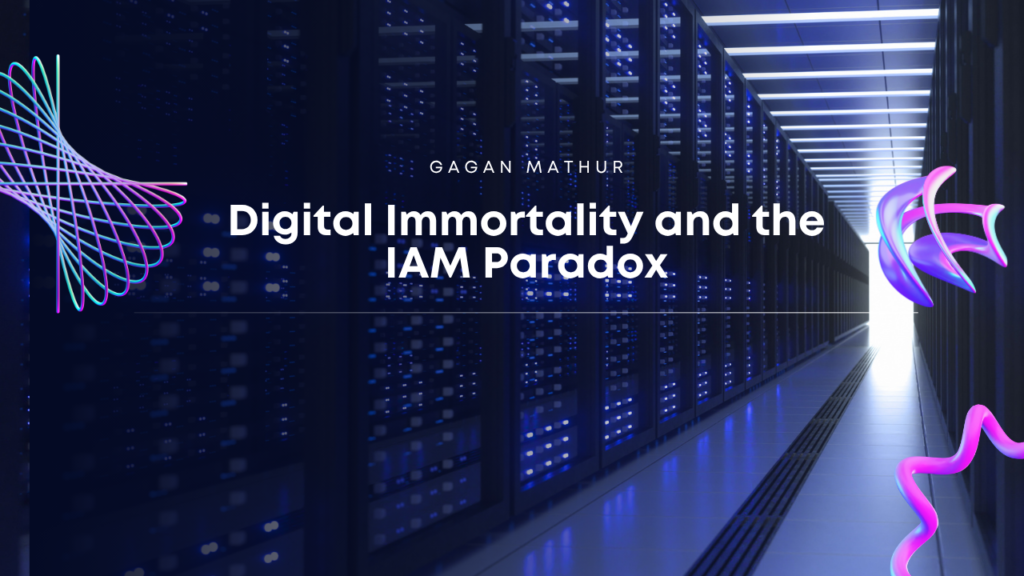Living Forever in the Cloud
Imagine uploading your thoughts, memories, and digital persona to the cloud, a future where your mind exists, interacts, and even evolves long after your physical form has faded. It sounds like science fiction, but rapid advancements in AI, neural interfaces, and cloud storage are inching us closer to “digital immortality.”
But with this futuristic possibility comes a disturbing question:
Who owns your digital self after you die? And more importantly, who protects it?
That’s where Identity and Access Management (IAM) in cybersecurity takes centre stage. In a world where your digital identity might persist indefinitely, IAM is no longer just an enterprise tool; it becomes an ethical, legal, and existential necessity.
IAM: The Gatekeeper of Digital Identity

In today’s digital-first ecosystem, Identity and Access Management (IAM) isn’t just a backend IT function; it’s the primary gatekeeper to trust, compliance, and resilience. As digital footprints expand exponentially across cloud services, remote workforces, and interconnected platforms, the security perimeter has shifted from networks to individual identities. IAM ensures that the right individuals gain the right access to the right resources, at the right time, and for the right reasons.
The landscape of IAM has matured from simple login credentials to a complex architecture involving multi-factor authentication (MFA), single sign-on (SSO), adaptive access controls, and privilege access management (PAM). These capabilities form the defence wall against the surge of phishing attacks, insider threats, credential stuffing, and privilege misuse. Real-time analytics now empower IAM tools to monitor user behaviour and detect anomalies, enabling proactive threat mitigation.
In the context of today’s hybrid and multi-cloud environments, IAM solutions also play a critical role in compliance and governance. From HIPAA to GDPR to India’s DPDP Act, data protection regulations demand strict control and auditability over user access. IAM provides automated provisioning, deprovisioning, and role-based access models that streamline compliance while reducing operational overhead.
Real-world breaches continue to highlight IAM’s indispensability. The SolarWinds hack and Uber’s internal system compromise stemmed from access mismanagement, illustrating how IAM isn’t optional but foundational. Organisations must treat IAM as a strategic pillar, embedding it within cybersecurity frameworks, DevSecOps pipelines, and digital transformation initiatives.
IAM is no longer a gatekeeper; it’s the architect of secure digital identities. Its evolution will only accelerate as AI and machine learning are integrated for contextual access decisions, identity intelligence, and dynamic trust scoring. In a future teeming with digital interactions, IAM remains our first line of defence.
At its core, IAM is the framework of policies, technologies, and processes that ensures the right individuals have the right access to technology resources. It’s the backbone of cybersecurity in enterprises, governments, and cloud infrastructures.
But as we move toward AI-driven personas and eternal digital records, IAM must evolve from a corporate utility to a guardian of posthumous identity. Here’s how:
1. Identity Lifecycle Management Beyond Life
Today, IAM manages identity creation, use, and deletion during a user’s active lifecycle. But what happens after death? If your digital persona continues to interact, IAM must:
- Recognise posthumous identities
- Manage consent-based access to your data
- Provide “identity executors” (akin to legal executors) with conditional privileges
2. Biometric Authentication and the Ethical Dilemma
Modern IAM systems use biometrics, fingerprints, retina scans, facial recognition. But in a post-life scenario, biometric authentication becomes obsolete. Instead, IAM will need behavioural analytics and contextual AI to validate interactions.
Real World Example: In 2022, a South Korean family interacted with a deceased child via a VR reconstruction. While emotionally powerful, such applications raise enormous ethical and access questions. IAM must determine:
- Who authenticated the system?
- What access level did the family have?
- Can the digital child “learn” or alter its memory bank?
3. IAM and AI-Driven Personas
AI can replicate tone, behaviour, and decisions using your digital footprint. In the future, people might interact with an AI that mimics your voice, personality, and opinions.
IAM’s Role in This AI Landscape:
- Verify Ownership: Ensure your AI-driven avatar is only controlled by authorised entities
- Control Evolution: Regulate how the AI version of “you” evolves posthumously
- Prevent Deepfake Abuse: With AI-generated personas, the line between real and fake blurs. IAM must distinguish legitimate AI identities from fraudulent ones
Example: In 2023, voice cloning technology was used to scam people out of thousands of dollars by impersonating loved ones. Imagine the consequences if your AI avatar is hijacked.
Additionally, AI personas could be licensed, sold, or modified for commercial purposes. Without IAM protections, digital twins of high-profile individuals (like artists, politicians, or thought leaders) could be manipulated or monetised without ethical clearance or compensation.
IAM can enforce traceability using blockchain to log every interaction, update, or AI evolution cycle, ensuring accountability in the age of synthetic personalities.
4. Cloud Storage and Eternal Data: IAM as the Firewall

As digital identities become increasingly untethered from our physical presence, the cloud emerges as both a sanctuary and a battleground. Cloud storage hosts everything, from our photos and emails to our behavioural patterns and even AI-generated personas. These digital remnants don’t just survive us; they evolve. But in this eternal realm of data, where fragments of our identity live on, who or what stands guard? The answer: Identity and Access Management (IAM).

IAM acts as a firewall not just in the technical sense, but as a socio-digital checkpoint. Without IAM, the permanence of cloud storage becomes a liability. Identity theft, unauthorised manipulation, and even AI impersonation are no longer hypothetical risks; they are unfolding realities. As data piles up across decentralised systems, IAM ensures that only those with verified permissions can interact with, modify, or access this information.
IAM’s role extends to monitoring anomalous behaviour using AI, enforcing role-based access controls, and supporting Zero Trust Architecture (ZTA). This security model assumes no user or system is inherently trustworthy. For instance, even if a family member gains access to your memorialised social media account, IAM protocols can ensure they don’t gain full administrative control unless predefined, consent-based conditions are met.
Real-world cases, such as unauthorised access to memorialised Facebook accounts, prove that insufficient IAM practices can erode both trust and digital dignity. As digital legacies become standard, IAM must be built not just to protect users during life, but to respect and secure their presence after death. With the right policies and technologies in place, IAM becomes the digital executor, firewall, and guardian of cloud-stored eternal selves.
In digital immortality, your identity lives in the cloud, across social media, emails, transactions, and even AI models. Without IAM, these fragments are vulnerable to:
- Data breaches
- Unauthorised access
- Manipulation and identity theft
Real World Case: Facebook’s policy on memorialised accounts allows loved ones to convert a deceased person’s account into a remembrance page. But users have reported hacks and data leaks due to weak IAM protocols.
IAM Recommendation:

- Cloud providers must implement Zero Trust Architecture (ZTA) to ensure no implicit access

- Use AI-based anomaly detection to flag unusual access to deceased profiles
- Employ cloud-native IAM with encryption key rotation and conditional access logic based on time-of-death digital triggers
5. Privacy Laws and Posthumous Consent

In today’s digital age, the scope of data privacy has extended far beyond the lifespan of an individual. As more personal data is stored in the cloud and across digital platforms, questions surrounding posthumous data ownership and control have become increasingly relevant. Privacy laws, while robust in certain regions, often lack clear directives on handling digital identities after death. This has led to varied interpretations of consent, access rights, and data deletion policies across countries and companies.
In the realm of Identity and Access Management (IAM), this introduces unique challenges. How should IAM systems treat digital identities that belong to deceased individuals? Should data access be automatically revoked, or should access be granted to legal heirs or trusted parties? These questions require frameworks that balance ethical, legal, and security dimensions.
Real-world incidents have amplified the urgency of this issue. For instance, in cases where families sought access to a deceased loved one’s cloud storage to retrieve memories or financial details, legal hurdles and privacy policies often prevented them from doing so. IAM tools powered by artificial intelligence could potentially recognise deceased status through integrated government records or activity metrics and trigger workflows for data retention, deletion, or delegation.
A future-proof approach would involve integrating digital wills or advanced consent settings into IAM platforms, allowing users to proactively define how their data should be handled posthumously. Governments, legal systems, and technology providers must come together to establish clearer frameworks that preserve both the dignity of individuals and the integrity of digital ecosystems.
As we stand on the cusp of a data-driven future, the intersection of IAM and posthumous privacy rights must evolve into a more structured, ethical, and universally accepted norm.
As digital identities become increasingly complex and enduring, the regulatory landscape around posthumous data management remains alarmingly underdeveloped. Privacy laws such as the General Data Protection Regulation (GDPR) in the European Union and the California Consumer Privacy Act (CCPA) in the United States are pivotal in governing data rights, but they fall short when it comes to protecting the digital legacy of deceased individuals.


6. Current Legal Gaps
- GDPR (EU): Although it provides extensive rights for data subjects, GDPR does not extend its scope to the deceased. This creates a legal grey area, especially when family members wish to manage or delete a loved one’s digital presence.
- CCPA (US): While emphasising consumer control, the law is silent on the digital data of deceased individuals, leaving it up to platforms or next-of-kin to define access and control.
7. The IAM Imperative
This legal vacuum places additional responsibility on Identity and Access Management systems to act as ethical and technical guardians of digital legacies. IAM must evolve to:
- Enable Digital Wills: Integrate pre-defined access rules that take effect upon death
- Use Smart Contracts: Automate posthumous data governance with blockchain-based contracts
- Support Identity Executors: Allow designated individuals to manage and monitor digital identities in compliance with predefined conditions
8. Real-World Implications
Consider cloud-based photo albums, emails, or AI chatbots trained on your persona. Without clear legal backing and IAM enforcement, these assets can be misused, erased, or exploited. IAM offers a proactive buffer by honouring consent, restricting unauthorised access, and enforcing the digital equivalent of last rites.
IAM isn’t just about managing life; it’s about safeguarding memory, agency, and digital dignity long after we’re gone.
IAM must comply with evolving data privacy laws:
- GDPR (EU): Does not currently cover post-mortem data
- California Consumer Privacy Act (CCPA): Silent on data of deceased persons
This legal vacuum poses a risk.
9. IAM Enhancement

- Implement digital wills with access governance
- Use smart contracts to manage consent flows


10. IAM and the Philosophy of Digital Afterlife
IAM now sits at the intersection of technology, philosophy, and ethics.
Questions IAM must answer:
- Should your digital self be able to evolve or must it remain static?
- Can a company modify your persona for monetization?
- Should your digital persona be “revived” without explicit lifetime consent?
IAM becomes the moral compass as well as the security framework. IAM can help encode ethics into digital systems, whether by enforcing immutable identity behaviours, allowing decay of outdated digital models, or archiving interactive histories with tamper-proof logs.
As AI-generated consciousness becomes a tangible reality, IAM is no longer optional; it’s foundational.
Conclusion: IAM is the Only Key to a Safe Digital Eternity
As we stand at the threshold of digital immortality, the stakes for cybersecurity have never been higher. IAM is no longer about user roles or logins; it’s about preserving the essence of human identity in an incorporeal world.
The future demands IAM systems that are:
- Context-aware
- AI-integrated
- Legally compliant
- Morally conscious
Because if we are to live forever in the cloud, someone must ensure we are not lost, stolen, or corrupted along the way.





